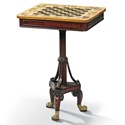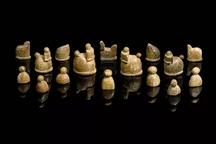While the origins of the game date back over a millennium (early precursors have been traced to the 6th century AD), its popularity in Europe really started to grow in the Medieval period as the game became played more widely, especially in royal courts.
Among the pieces still in existence from this period are those from the famous Lewis chessmen hoard – the cache of 12th or 13th century walrus ivory carvings that now chiefly resides in the British Museum.
Later, as books about chess began to be published especially after Gutenberg created his revolutionary printing press in c.1440, the game began to assume a more general form during the 16th century.
Yet even in the 18th century sets were still yet to be fully standardised, and this variety of pieces and sets provides plenty of scope for collecting.
English and European classics from this time include the ‘spikehead’ form or the ‘Philidor’ sets as used by the French composer and chess player François-André Danican Philidor (1726-95) on his regular tours to England.
The many 19th century chess designs (most displaced by the Staunton pattern by the early 20th century, see below) include the Northern or Edinboro’ Uprights, the St George and the Old English sets.

A European carved and turned boxwood and macassar ebony chess set that sold for £1200 at Semley of Shaftesbury, Dorset in January 2020.
Staunton pattern
With the advent of international chess tournaments in the Victorian era, it became clear that a standard size and shape for the ancient game's 32 pieces was required.
It was Nathaniel Cook's ‘Ornamental Design for a Set of Chess Men’ patented on March 1, 1849 that made the winning move.
The so-called Staunton pattern was named after the English chess master Howard Staunton (1810-1874) who penned a regular column for the Illustrated London News where Cook was editor. Daring in its pared-down simplicity, but relatively cheap to produce, the new set’s commercial possibilities were immediately grasped by the leading Hatton Garden purveyor of fine games John Jaques.
It was a family affair: Jaques was Cook’s brother-in-law.
According to adverts in the Illustrated London News dated September 8, 1849, the first Jaques Staunton pattern sets were available in “the finest African ivory (5 guineas), boxwood and ebony (£1/15 shillings or club size at £2/5 shillings) and Wedgwood’s Carrara (£2/12/6 shillings)”.
The first 500 sets were sold in distinctive gothic revival style carton-pierre boxes designed by one Joseph L. Williams with labels hand signed and numbered by Howard Staunton himself. They are now very rare and a box alone can cost several thousand pounds.
One (a large sized box for a Carrara set) appeared for sale at H&H Auctions in Carlisle in 2012 and took £5800. Later versions carry the Staunton signature in facsimile and are more modestly priced in the hundreds.
All sorts of minutiae are involved in the dating of the early Staunton issues – particularly subtle variations in the form and carving to the knights whose ‘horse of Selene’ design was borrowed from the Elgin Marbles.
What buyers look for
In commercial terms, when it comes to antique chess sets, most examples are rated by the following criteria:
- Maker – alongside Jaques, the wares of fellow British makers John Calvert, William Lund and George Merrifield are much admired
- Material – many antique sets are made of bone or wood, while others may be made from ivory which was far more costly to produce. Buyers should always be aware of the current regulations on the trade in antique ivory objects
- Size – typically the larger the better
- Quality of carving – this is particularly pertinent to the many Indian and Chinese ivory chess sets exported in great numbers to Europe in the 19th century that can vary in price from two- and modest three-figure sums into the thousands
- Condition – antique chess sets are susceptible to damage such as chips to the pieces and staining, scuffs and general wear to the board. Look out for any cracks and minor losses to the box too
While some buyers also like to hunt down novelty sets, other items that chess collectors may look for include related objects such as chess clocks, chess books, competition memorabilia relating to famous players of the game and pieces of furniture like games tables.
Where to look
The best place to find antique chess items is through specialist dealers or at the occasional specialist chess collecting auctions held in the UK and the US. At these sales the range of memorabilia is broadened to include chess-related literature, competition ephemera and the autographs and possessions of famous players.
Otherwise, most general antiques sale will include a chess-related item or two so it is well worth using a couple of different search terms to find your quarry.














